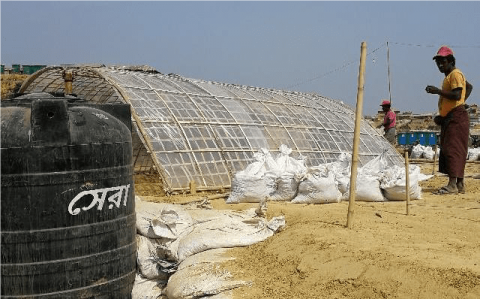Lime Stabilization - Unplanted Drying Beds
Description of the emergency context
Description of the treatment process
No description
Assessment & design (feasibility)
On average 5m3 sludge is treated per day, which is in accordance with a target population of 10,000 people served with FSM activities and a sludge accumulation rate of 0.5 l/person/day.
Desludging and sludge treatment efforts seem to answer to the need in our 23 blocks (9,383 people). However the actual number of people reached is somewhat lower as all latrines constructed under supervision of Save the Children and Friendship are normally emptied by these respective organisations.
Other FSM actors state a two-week period between desludging, which calculates to a sludge accumulation rate of 2.9 l/cap/day (assuming full latrines, 0.8 m3, after two weeks).
The adddition of hydrated lime (Ca(OH)2) to faecal sludge increases pH and results in pathogen inactivation and limited sludge stabilization [1]. Different combinations of pH and exposure times result pathogen removal, field research has shown that faecal sludge from pit latrines treated at pH > 11.5 for a period of 2 hours meets WHO standards [2].
Loading rate 5 m3/day assumption: 0.5 l/person/day, 10,000 people
Lime dosage rate 20 kg/m3 sludge typical range: 1 – 17 kg/m3 faecal sludge
Lime consumption 100 kg/day actual lime use 110 kg/day
Before desludging a 1:1 lime-water mixture is added to the barrels. Once the barrel is carried back to the site the content is stirred for approximately one minute followed by pH measurement.
The unplanted drying beds are designed for a hydraulic loading rate of 30 cm/m2 and a solid loading rate of 200 kg TS/m2/year [1; 3]. The unlined beds (5x2 metres) are filled with coarse gravel topped with sand and a permeable sand bag cover to allow for easy removal of the dried sludge and to avoid sand removal during bed emptying.
Loading rate 5 m3/day assumption: 10,000 people, 0.5 l/person/day
Hydraulic loading rate 30 cm/m2 typical range: 25 – 30 cm/m2 [1]
Solid loading rate 150 kg TS/m2/year typical range: 100 – 200 kg TS/m2/year [3]
Drying time 7 days assumption: 1% total solids concentration
Drying area required 100 m2 0.01 m2 / person equivalent
Lime stabilisation is a simple and robust technology that can be designed, constructed and operated in the local context. Design is straightforward and can be done by a WaSH officer. Construction and operation and maintenance do not require prior knowledge and experience.
The site has been reinforced and is protected against flooding.



Add new comment